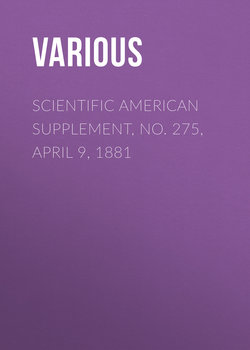Читать книгу Scientific American Supplement, No. 275, April 9, 1881 - Various - Страница 10
THE GUENON MILK-MIRROR
ОглавлениеThe name of the simple Bordeaux peasant is, and should be, permanently associated with his discovery that the milking qualities of cows were, to a considerable extent, indicated by certain external marks easily observed. We had long known that capacious udders and large milk veins, combined with good digestive capacity and a general preponderance of the alimentary over the locomotive system, were indications that rarely misled in regard to the ability of a cow to give much milk; but to judge of the amount of milk a cow would yield, and the length of time she would hold out in her flow, two or three years before she could be called a cow–this was Guenon's great accomplishment, and the one for which he was awarded a gold medal by the Agricultural Society of his native district. This was the first of many honors with which he was rewarded, and it is much to say that no committee of agriculturists who have ever investigated the merits of the system have ever spoken disparagingly of it. Those who most closely study it, especially following Guenon's original system, which has never been essentially improved upon, are most positive in regard to its truth, enthusiastic in regard to its value.
The fine, soft hair upon the hinder part of a cow's udder for the most part turns upward. This upward-growing hair extends in most cases all over that part of the udder visible between the hind legs, but is occasionally marked by spots or mere lines, usually slender ovals, in which the hair grows down. This tendency of the hair to grow upward is not confined to the udder proper; but extends out upon the thighs and upward to the tail. The edges of this space over which the hair turns up are usually distinctly marked, and, as a rule, the larger the area of this space, which is called the "mirror" or "escutcheon," the more milk the cow will give, and the longer she will continue in milk.
ESCUTCHEON OF THE JERSEY BULL-CALF, GRAND MIRROR, 4,904.
That portion of the escutcheon which covers the udder and extends out on the inside of each thigh, has been designated as the udder or mammary mirror; that which runs upward towards the setting on of the tail, the rising or placental mirror. The mammary mirror is of the greater value, yet the rising mirror is not to be disregarded. It is regarded of especial moment that the mirror, taken as a whole, be symmetrical, and especially that the mammary mirror be so; yet it often occurs that it is far otherwise, its outline being often very fantastical–exhibiting deep bays, so to speak, and islands of downward growing hair. There are also certain "ovals," never very large, yet distinct, which do not detract from the estimated value of an escutcheon; notably those occurring on the lobes of the udder just above the hind teats. These are supposed to be points of value, though for what reason it would be hard to tell, yet they do occur upon some of the very best milch cows, and those whose mirrors correspond most closely to their performances.
Mr. Guenon's discovery enables breeders to determine which of their calves are most promising, and in purchasing young stock it affords indications which rarely fail as to their comparative milk yield. These indications occasionally prove utterly fallacious, and Mr. Guenon gives rules for determining this class, which he calls "bastards," without waiting for them to fail in their milk. The signs are, however, rarely so distinct that one would be willing to sell a twenty-quart cow, whose yield confirmed the prediction of her mirror at first calving, because of the possibility of the going dry in two months, or so, as indicated by her bastardy marks.
It is an interesting fact that the mirrors of bulls (which are much like those of cows, but less extensive in every direction) are reflected in their daughters. This gives rise to the dangerous custom of breeding for mirrors, rather than for milk. What the results may be after a few years it is easy to see. The mirror, being valued for its own sake–that is, because it sells the heifers–will be likely to lose its practical significance and value as a milk mirror.
We have a striking photograph of a young Jersey bull, the property of Mr. John L. Hopkins, of Atlanta, Ga., and called "Grand Mirror." This we have caused to be engraved and the mirror is clearly shown. A larger mirror is rarely seen upon a bull. We hope in a future number to exhibit some cows' mirrors of different forms and degrees of excellence.–Rural New Yorker.
